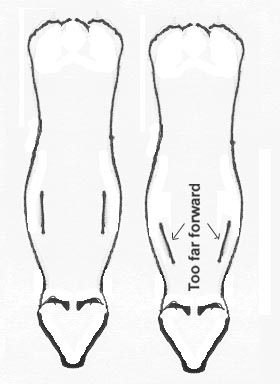The next thing I would like to address is the placement of the shoulder blade on
the side of the chest of the dog. When the shoulder blade is set properly on the
side of the chest, there will be a nice rounding of the chest. If they are set
too far forward the blades then point towards each other and you will often see a
dog out at the elbows that also toes in. When shoulders are placed too far forward
the muscles holding the blade in place are usually not strong enough to prevent
paddling.
 |
The sketch on the left shows proper placement (often referred to as the
way the shoulder blade is "laid on" as opposed to "layback") of the shoulder blade.
The dog on the right has shoulder blades that are placed too far forward on the
chest of the dog. You can easily see how the blades point toward each other more
and could cause the elbows to turn out and the feet to toe in. |
Paddling is seen when viewed from the front. The dog has a loose front that
has a circular
motion of the front feet. The motion is reminiscent of the motion of the paddle
when paddling a canoe. The blade of the paddle must turn or else the canoe will
go in a circle - hence the name paddling. The most common causes are muscles that
are too loose or shoulder blades that are too far forward on the chest. Faulty
motion such as paddling can be seen in the front because the ball and socket
joint of the shoulder (indeed where the shoulder blade and upper arm meet) allows
more freedom of motion (other than just forward and backward) so that you can get
the leg moving in a circular motion. Even though the shoulder joint can move in
all directions - because of the placement and attachment of the muscles and the
way the cavity of the socket of the joint is formed, there is still more freedom
of motion back and forth. The other joints in the front leg are hinges (such as
at the elbow) which basically only allow for motion toward the front and toward
the rear.
Whenever you discuss the bone structure of the dog, you must remember that the
bone has no way of creating motion - it is a support structure only. It takes
muscles to move those bones. Overall conformation is determined not only by the
condition of the muscles, but their size, shape and distribution in conjunction
with the skeleton of the dog. Some dogs have shorter, "bunchier" muscles, others
have longer, sleeker muscles - think Bull Terrier and Whippet as examples. You don't
want bunchy muscles on a Corgi, but you don't want them as long and sleek as they
are on a whippet (but it is far better to have them lean toward the Whippet than
the Bull Terrier.)
As far as reach is concerned, as was stated before, the forward reach of a dog is
usually about the same angle of the shoulder blade at rest. The length of the upper
arm can also affect forward reach. A short upper arm also shortens reach in front.
Return to Main Page

